21 Best QA Testing Tools For 2024
In the Software Development Life Cycle (SDLC), software testing is one of the most crucial phases, either performed manually or through automation. Manual testing requires human intervention, whereas automated testing is performed using QA testing tools and frameworks. Such tools help automate repetitive tasks in your QA process.
However, with such a diverse number of QA testing tools available, choosing the most appropriate one for the software project is challenging.
In this blog, we will explore the 21 best QA testing tools and understand their key features so that you can select the right one based on your testing requirements.
What Are QA Testing Tools?
QA testing tools play a critical role in the software development process, helping ensure the quality of the software application with respect to its requirements.
Software development teams rely on QA testing tools to verify that their releases meet project specifications, deliver a top-notch user experience, and minimize bugs and defects. These tools help developers and testers with tasks like writing effective test cases, performing test executions, and monitoring results.
Furthermore, QA testing tools facilitate the analysis of individual software features or modules for potential bugs or defects.
Why Use QA Testing Tools?
QA testing tools are a crucial part of test automation that allows the verification and validation of the software application in a hassle-free manner.
Here are some of the common reasons why to use QA testing tools:
Improves test coverage: QA testing tools thoroughly test software applications, ensuring all functionalities are covered according to end-user requirements.
Minimizes testing expenses and time: Regular software updates necessitate repetitive testing to ensure all features function flawlessly and eliminate bugs. Using QA testing tools enables the execution of test scripts across various browsers, devices, and platforms, streamlining the process through automation. These tools can run tests continuously, saving considerable time.
Enhances uniformity and reproducibility: QA often performs tasks with different use cases, even when attempting to replicate the same actions. QA testing tools precisely replicate previous actions, ensuring consistent results with each iteration.
Boosts efficiency: QA testing tools streamline the testing process and boost the team’s productivity and accuracy, ensuring software quality.
Syncs with CI/CD and DevOps: QA testing tools facilitate the easy transition to Continuous Integration/Continuous Delivery (CI/CD) practices, enabling seamless test automation for DevOps environments.
Provides reporting capabilities: QA testing tools provide detailed test reports for each executed test case, offering visual logs with insights into completed or scheduled test cases, reported defects, and corresponding fixes.
Best 21 QA Testing Tools
Until now, we have discussed QA testing tools and their importance; let’s look at some of the best QA testing tools that you can opt for in 2024.
1. LambdaTest
LambdaTest is the AI-powered test orchestration and test execution platform. It allows the execution of manual and automation testing on a remote test lab of 3000+ real devices, browsers, and OS combinations. It lets developers and testers perform QA testing of your websites and mobile applications across real and virtual environments.
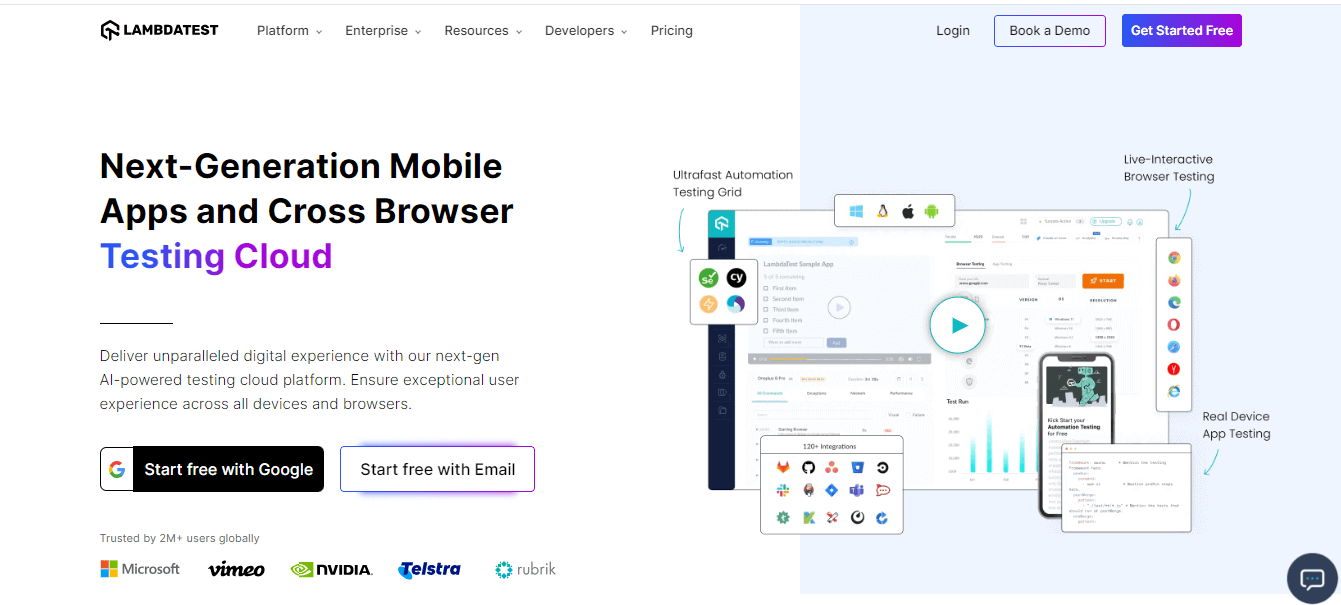
Key Features:
Facilitates integration with automation testing tools, including Selenium, Playwright, Cypress, Puppeteer, Taiko, Appium, Espresso, XCUITest, and more.
Offers AI-powered visual regression testing, which automatically compares across different browsers and devices to highlight visual inconsistencies.
Enables live-interactive and automated screenshot testing across environments.
Accelerate test automation with HyperExecute, a high-speed end-to-end test orchestration cloud.
Perform geolocation testing of web and mobile apps across 53+ geographical locations.
Provides integrations with CI/CD tools, project management platforms, and codeless automation solutions.
Offers popular QA certifications to validate your QA testing expertise.
2. Selenium
Selenium is an open-source framework that allows testers to perform web automation. This framework was developed in 2004, and it has three main components: Selenium IDE, Selenium WebDriver and Selenium Grid. It makes the QA test process very easy due to the following features:
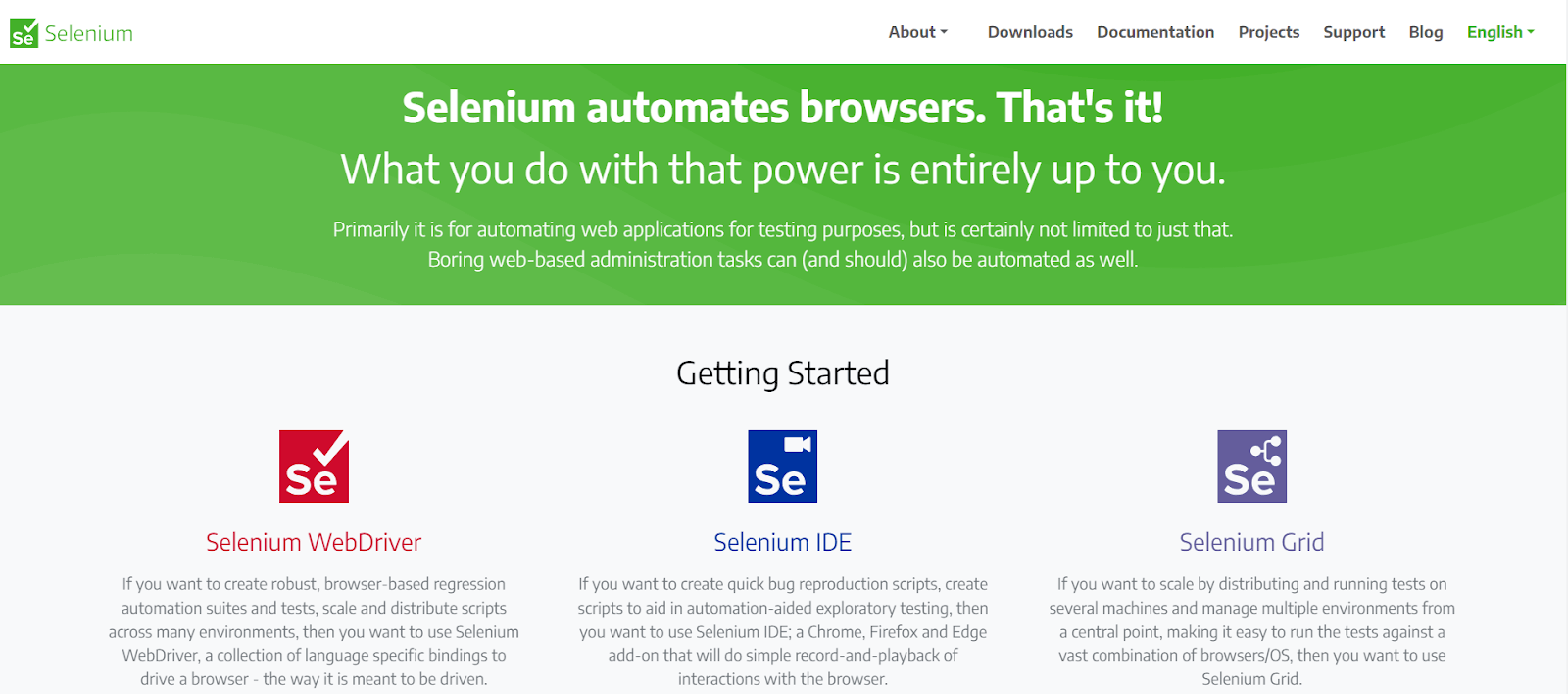
Key Features:
Facilitates test execution on both local machines and remote servers via the Selenium server, offering flexibility in testing environments.
Implements parallel executions to optimize testing workflows, reducing execution time and increasing test coverage.
Enables headless browser testing, enhancing testing capabilities without needing a graphical interface.
Integrates with popular frameworks such as Ant and Maven for efficient source code compilation and management.
Offers compatibility with test automation frameworks like TestNG, enabling thorough application testing and simplified report generation.
Requires minimal resources compared to other automation testing tools, ensuring optimal performance even in resource-constrained environments.
3. Playwright
Playwright, developed by Microsoft, is an open-source QA testing tool for end-to-end testing. It empowers developers and testers to automate website testing across different browsers and platforms. With an API, Playwright enables effortless cross-browser testing and supports JavaScript, TypeScript, and Node.js.
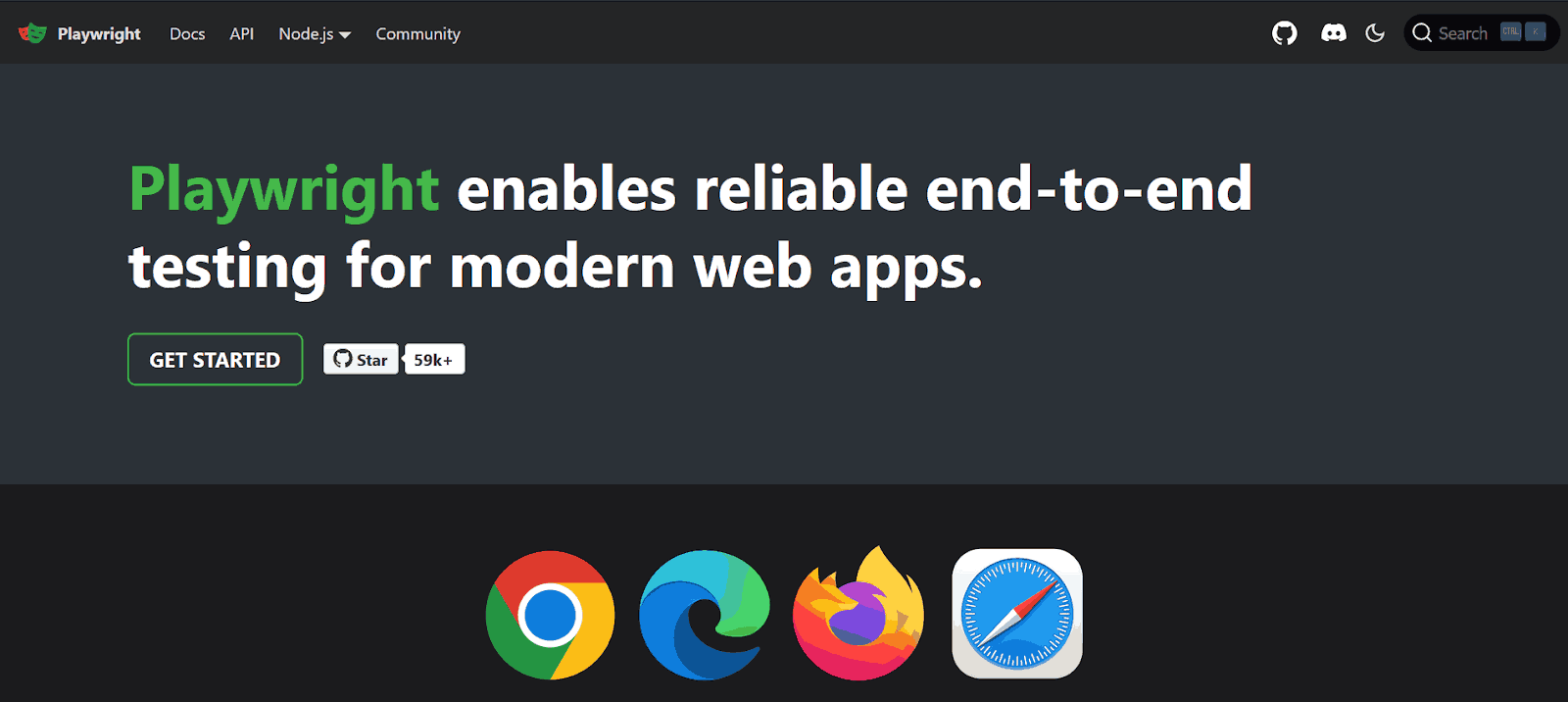
Key Features:
Tests web applications across various mobile, web, and desktop platforms.
Supports multiple browsers, such as Chrome, Firefox, Edge, Chromium, and WebKit.
Offers bindings for Java, JavaScript, TypeScript, Python, and C#, widening its accessibility.
Provides the option to run browsers in headless mode for faster execution in test environments or GUI mode for development and debugging.
Automates browser interactions like button clicks, form submissions, and page navigation.
Waits for elements to be ready before executing actions minimize flaky tests and eliminate the need for manual waits.
Integrates with other CI environment tools and frameworks, enabling continuous testing.
4. Cypress
Cypress is a popular QA testing tool for modern web applications. It lets developers and testers perform front-end testing, which means writing automated tests to ensure web applications function correctly.
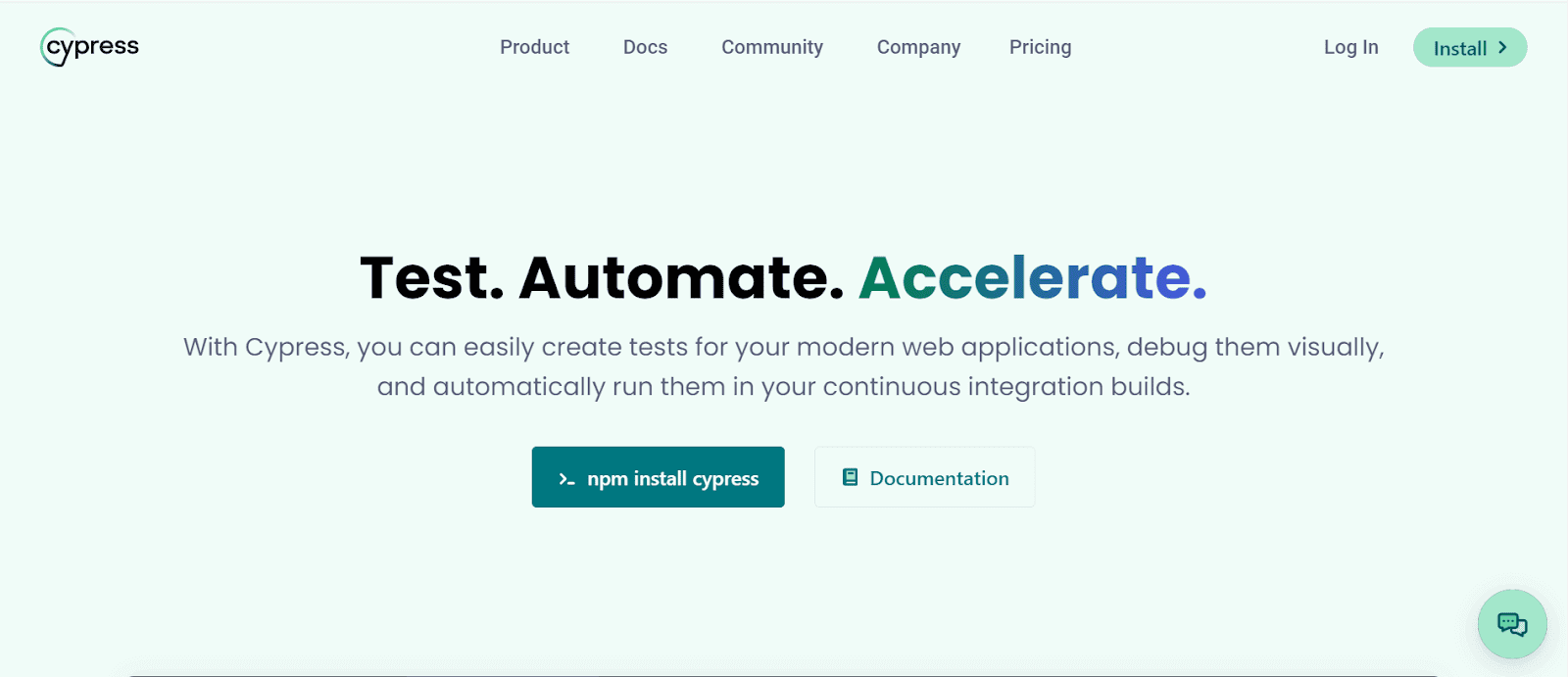
Key Features:
Works directly within the browser, eliminating the need for additional software installation.
Supports different browsers like Google Chrome, Mozilla Firefox, WebKit, and others.
Comes with predefined libraries and dependencies, so no additional configuration is necessary.
Provides automatic scrolling. So, before executing an action, automatic scrolling displays the entire view of every element.
Offers to capture screenshots during test runs.
Automatically waits for statements and commands before proceeding — no need for implicit or explicit wait commands in test scripts.
Offers a hassle-free debugging process.
5. Puppeteer
Developed by Google, Puppeteer is a Node.js library offering an advanced API to manage Chrome/Chromium through the DevTools Protocol. By default, Puppeteer operates in headless mode, yet it’s adaptable to run in the complete Chrome/Chromium environment.
Using JavaScript commands, Puppeteer allows testers to execute various actions, including link clicks, form completions, and button submissions.
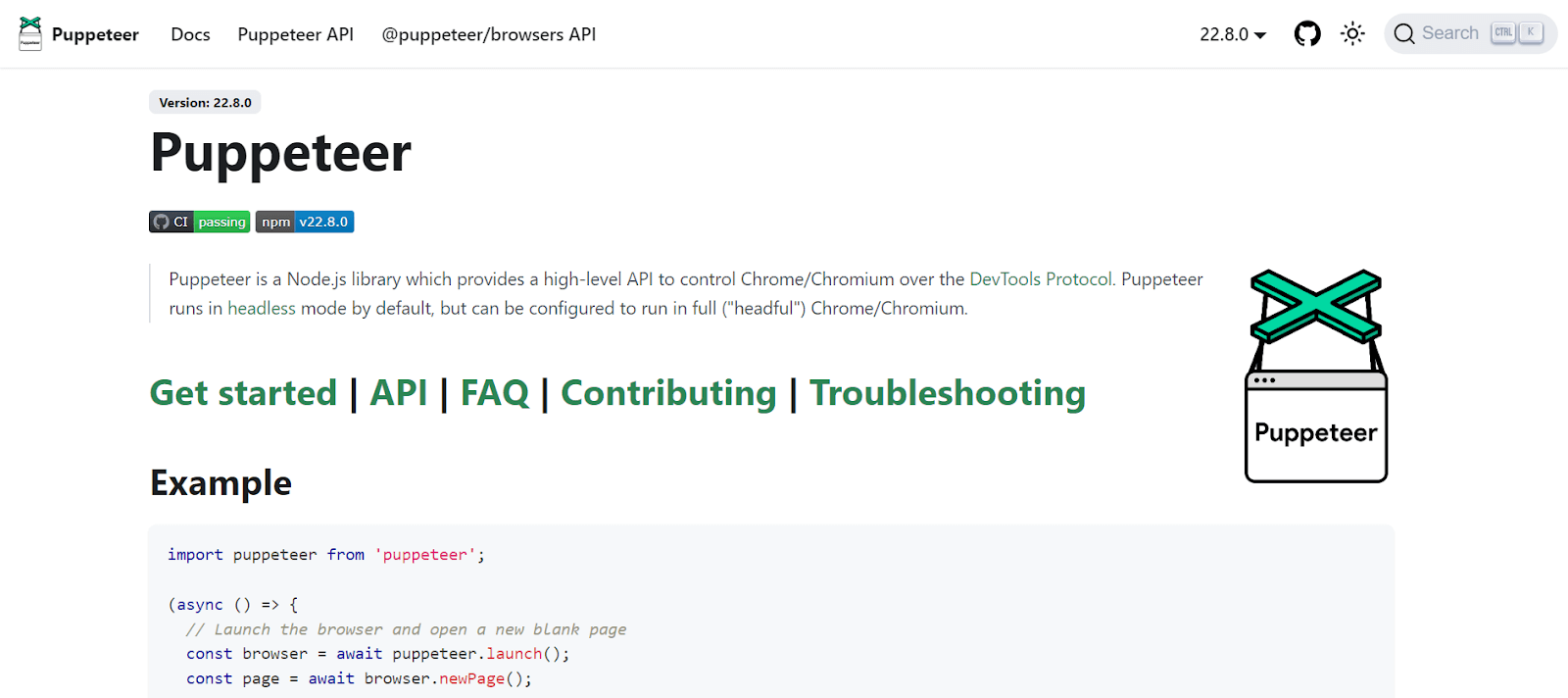
Key Features:
Establishes a testing environment facilitating seamless updates and execution in the latest Chrome version, incorporating JavaScript, browser functionalities, and APIs.
Supports comprehensive cross-browser and cross-platform testing and is compatible with diverse operating systems and programming languages.
Integrates with leading CI and Agile tools like Jenkins, Travis CI, and TeamCity.
Functions effectively as a crawler for Single-Page Applications (SPAs) and generates pre-rendered content via Server-Side Rendering (SSR).
Enables automation of form submissions and other web browser interactions.
6. Appium
Appium is a robust solution for automating mobile applications, offering adaptability and power to developers and quality assurance teams. Its cross-platform compatibility simplifies mobile app testing, allowing for easy automation of test scripts for both Android and iOS devices. Being open-source fosters collaboration and continuous development within the developer community.
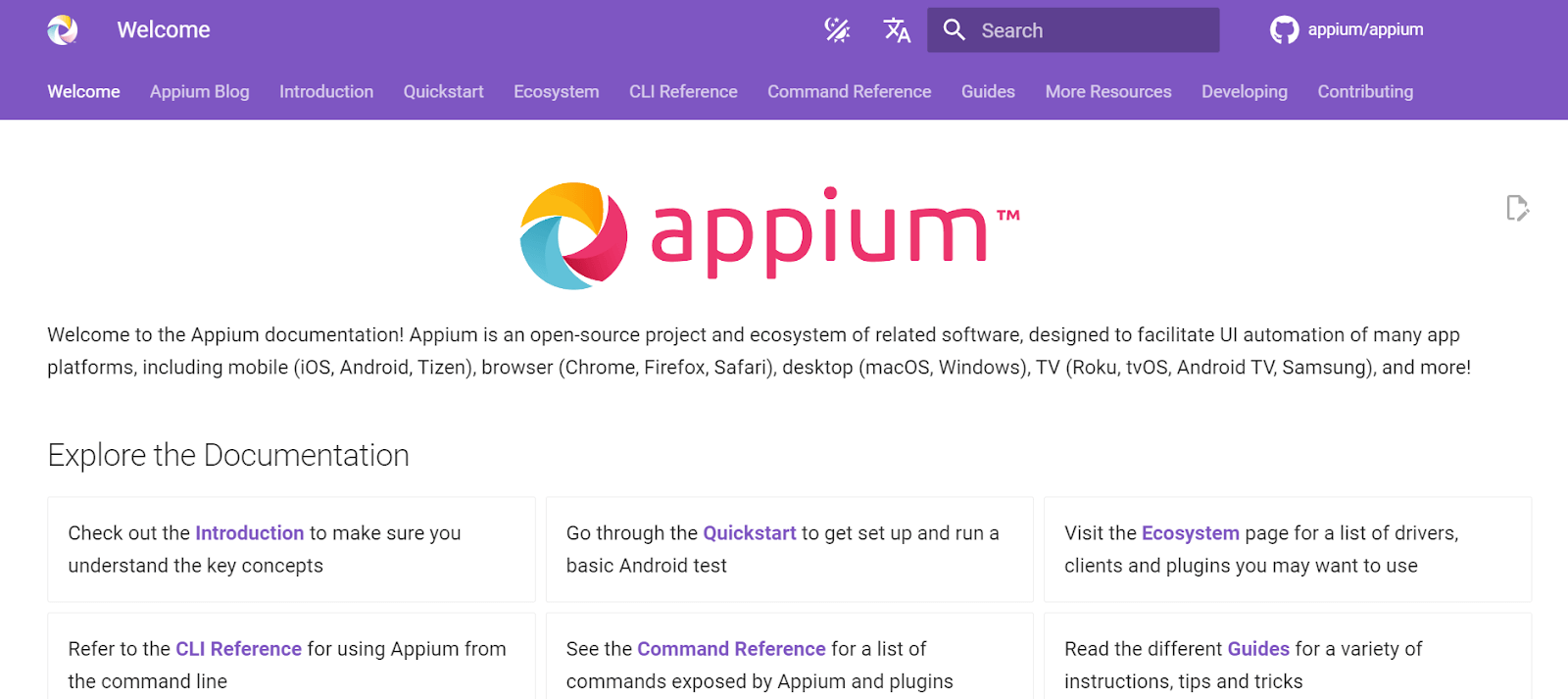
Key Features:
Stands out as a versatile framework enabling testers to execute comprehensive and efficient mobile application testing across various platforms, including Android and iOS.
Facilitates mobile testing on real devices, providing a more authentic testing environment compared to emulators or simulators.
Tests native, web, and hybrid apps on both Android and iOS.
Supports multiple programming languages, including Java, Python, C#, Ruby, Perl, and more.
Works without needing access to the application’s source code being tested.
Offers built-in support for popular mobile gestures and interactions.
Integrates with cloud-based testing platforms and CI/CD tools like Jenkins.
7. Espresso
Espresso is the QA testing tool for Android mobile applications. It is a specialized framework for automating UI tests on Android. It is developed and maintained by Google; Espresso stays consistently updated with the latest features of the Android OS. Being open source, it’s easily accessible and extendable within the Android Studio IDE environment, making it convenient for developers.
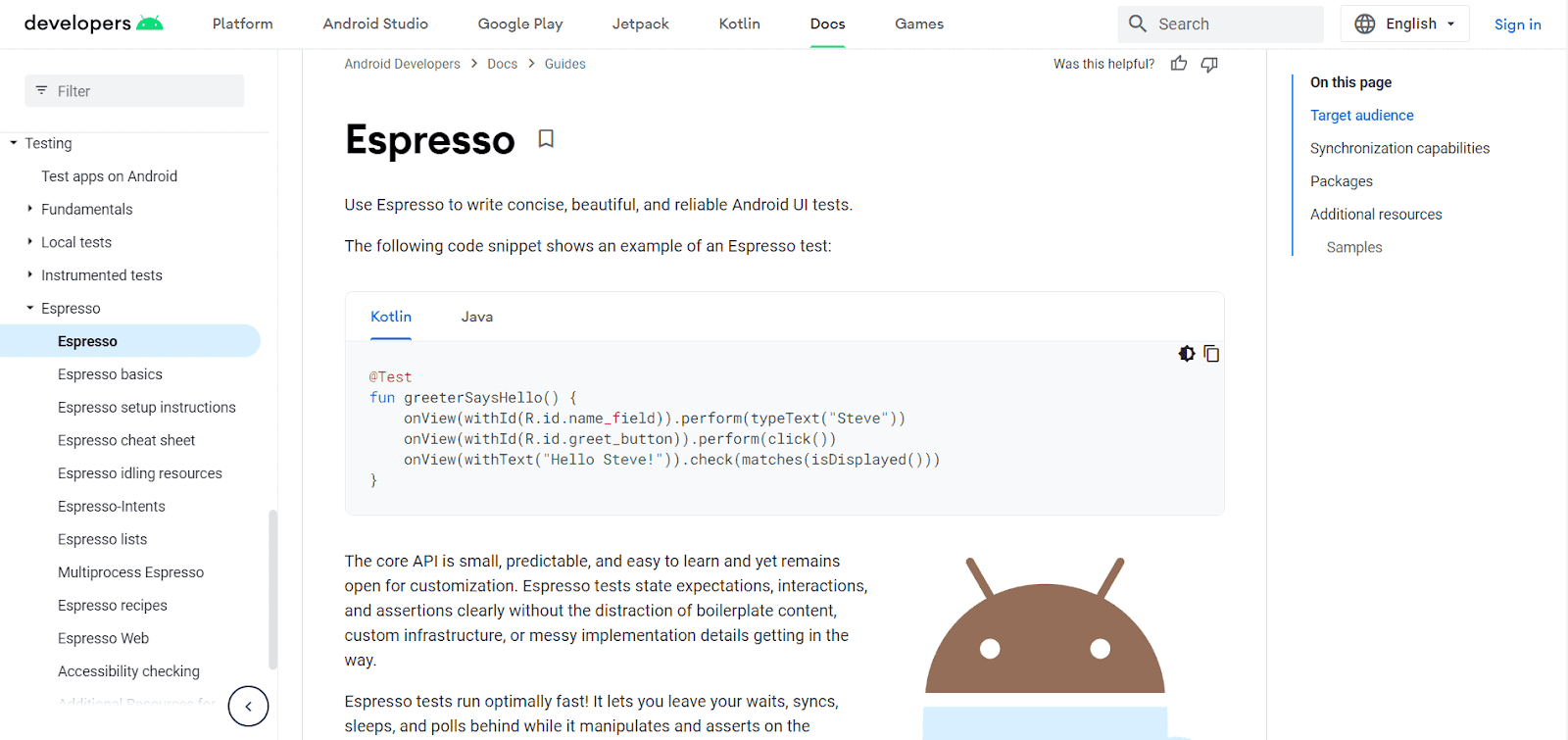
Key Features:
Comes with the Espresso Test Recorder that enables the creation of UI tests without the need to write test code manually.
Offers automatic synchronization with user interface elements and test actions within the framework.
Provides a wide range of ViewMatchers and ViewActions for locating and interacting with UI elements.
Provides a dedicated module for WebView testing and testing/mocking Android Intents.
8. XCUITest
Built on top of XCTest, XCUITest is a UI testing framework developed by Apple to perform iOS automation testing of native apps and even macOS applications. It integrates with the Apple Xcode development environment and allows you to write tests in Swift or Objective-C programming languages.
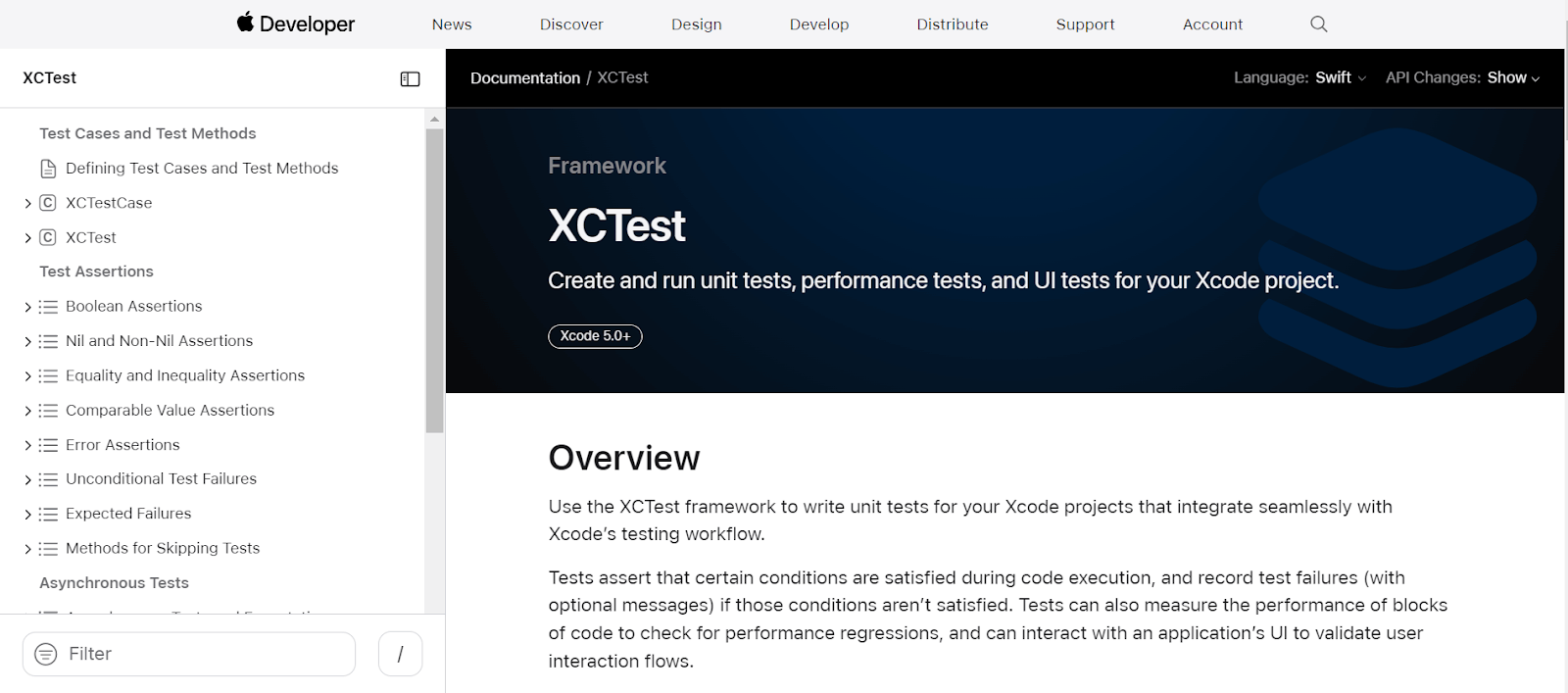
Key Features:
Supports Swift & Objective-C for writing tests that interact with UI elements.
Integrates with accessibility features and offers recording/playback functionality.
Verify expected test results with ease using the included assertion library.
Simulates user actions (taps, swipes) to automate workflows and test app functionality.
9. Cucumber
Cucumber, an open-source QA testing tool developed in Ruby, creates easily understandable test cases accessible to individuals with varying technical backgrounds. It’s particularly favored for Behavior-Driven Development (BDD), which prioritizes tests that are understandable to all.
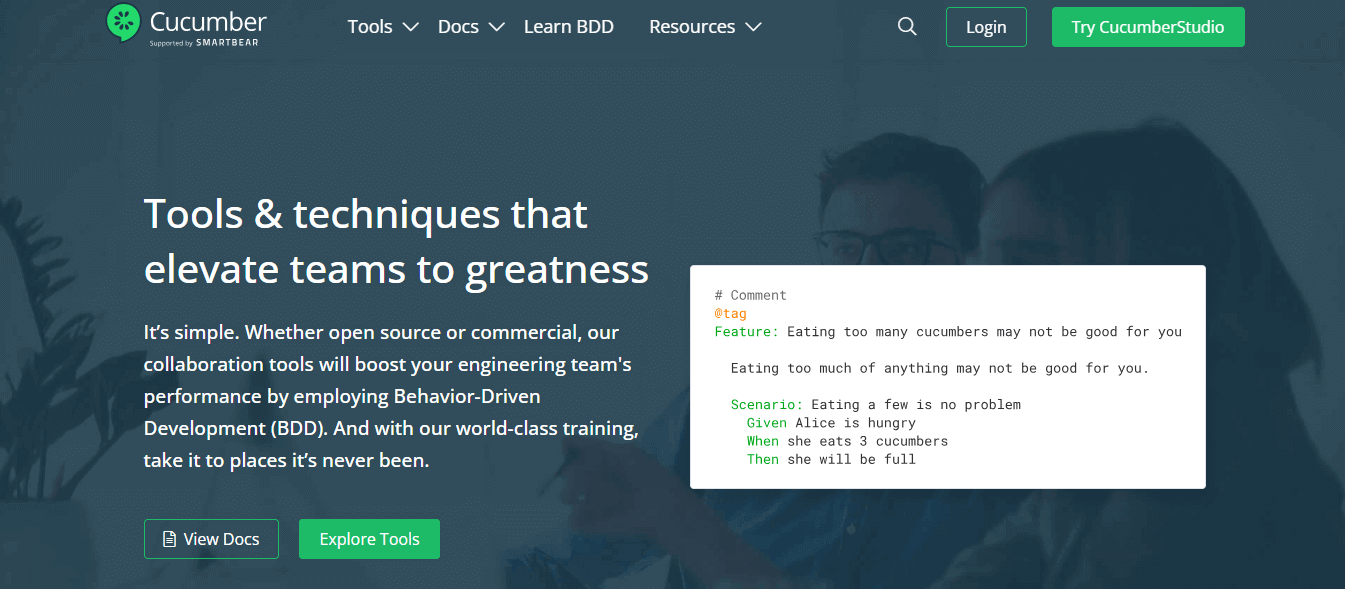
Key Features:
Simplifies BDD testing with Gherkin syntax for clear communication.
Comes with executable specifications for automated testing.
Separates test logic for better readability and maintainability.
Integrates with various programming languages and is platform-independent.
10. WebdriverIO
The WebdriverIO framework is a QA testing tool that works on Node.js and allows testing through JavaScript/TypeScript. WebdriverIO offers flexibility in protocol usage, supporting both WebDriver and ChromeDevTools protocols. This will enable you to choose the most suitable approach for interacting with web browsers during testing.
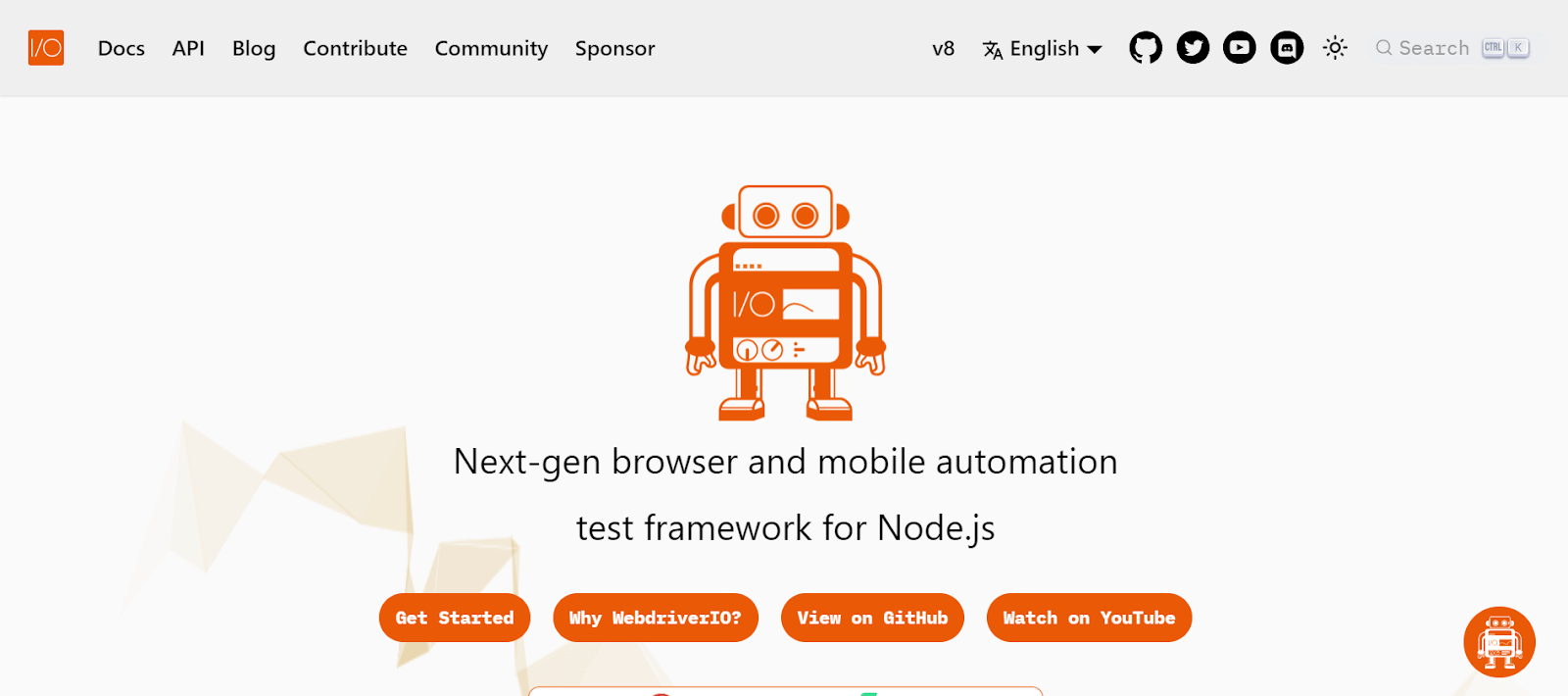
Key Features:
Offers an easy setup. All you need to do is install Node packages via npm and start testing.
Facilitates automation testing for both web and native mobile applications.
Leverages the WebDriver protocol to ensure standardized browser automation.
Boasts compatibility with various browsers like Chrome, Edge, Firefox, Internet Explorer, and Safari.
Allows seamless switching between multiple windows and tabs during testing.
Avoids imposing restrictions concerning iframes, enabling testers to automate scenarios involving them using basic WebDriver commands.
Integrates with CI/CD tools like Jenkins and Azure when executing WebdriverIO tests.
Allows tester to scale their testing efforts by configuring WebdriverIO to launch multiple instances and execute tests concurrently.
11. Robot Framework
Robot Framework enables developers and testers to run Acceptance Test-Driven Development (ATDD). It uses different test case styles like keywords-driven, behavior-driven, and data-driven to write test cases.
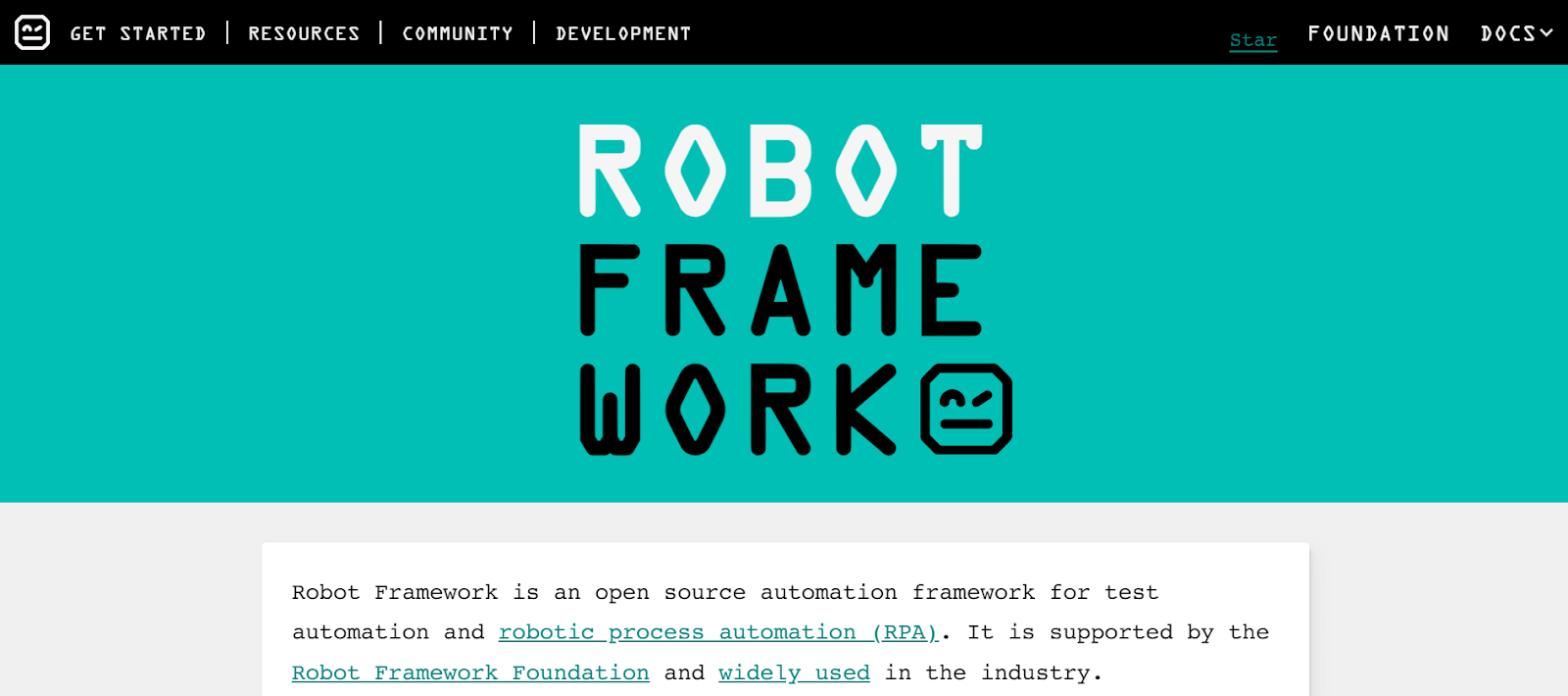
Key Features:
Supports external libraries and tools, enabling test automation through open-source resources.
Provides testing for both web-based and desktop-based applications.
Offers testing using the keyword-driven approach, enabling testers to write test cases using natural language syntax and easily reusable keywords.
Boasts a diverse range of built-in libraries, including testing for HTTP, FTP, SSH, XML, user interfaces, and databases.
12. Functionize
Functionize is a leading QA testing tool that harnesses AI to provide teams with end-to-end tests that automatically adapt and work at scale in the cloud.
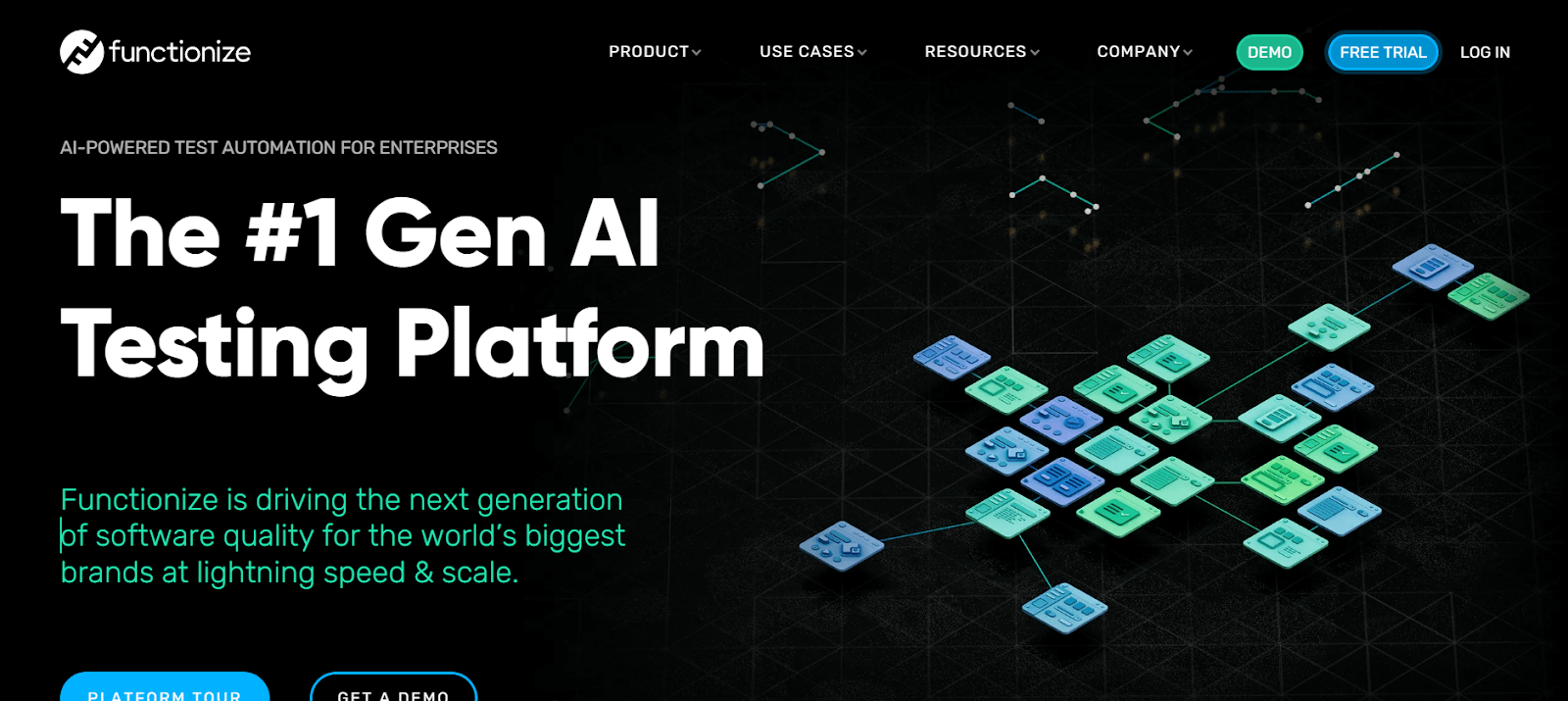
This results in quicker testing, cost savings, and better quality in CI/CD setups. Its AI-driven platform creates more stable tests through its unique big data approach. Additionally, it empowers teams and prepares them for the future by offering low-code intelligent tests, reducing the reliance on highly technical individuals for test automation.
Key Features:
Reduces test debt by automating fixes for broken tests, easing ongoing maintenance.
Saves test engineer time by accurately learning how the UI functions.
Relies on a cloud-based infrastructure, making it dependent on a stable Internet connection. This might pose challenges for organizations with offline testing requirements.
13. testRigor
testRigor is a QA testing tool for automated software testing. Its primary purpose is to help organizations achieve comprehensive test coverage while reducing testing time and effort. Through Machine Learning and Artificial Intelligence, testRigor provides an intelligent testing approach to help teams detect and address defects early in the development cycle.
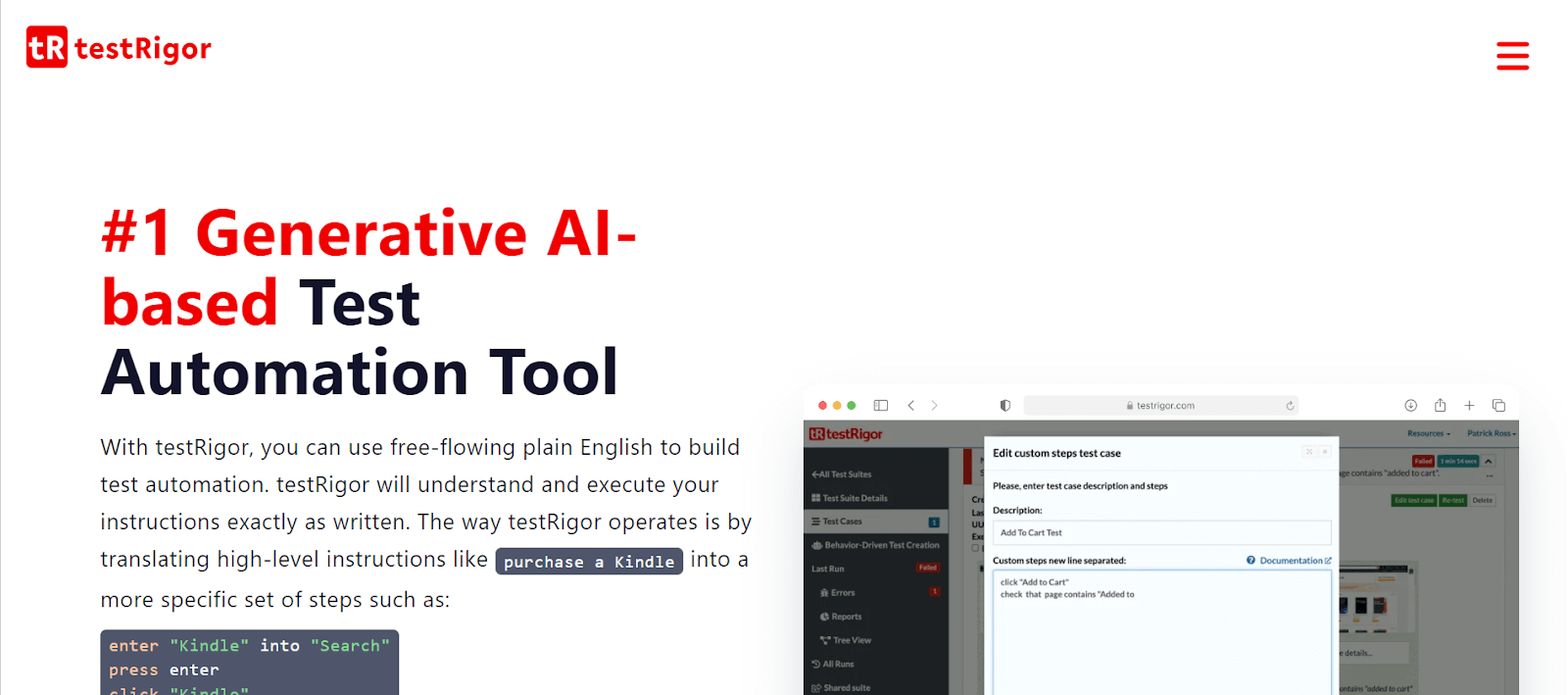
Key Features:
Uses Generative AI for testing to generate tests based on documented test scenarios.
Supports mobile testing, including physical device testing through partnerships and hybrid app testing.
Simplifies email testing by providing renderings for functionality assessment and enabling easy interaction with email buttons to extract codes.
Enables API testing and offers API call mocking.
Performs data-driven testing with support for various datasets, including CSV files.
Provides a user-friendly interface to eliminate the need for complex scripting.
14. Ranorex Studio
Ranorex is a powerful QA testing tool for performing test automation. It functions as a GUI test automation framework, addressing the testing needs of various applications, including web-based, desktop, and mobile applications. Unlike other tools, Ranorex Studio makes use of standard programming languages like VB.NET and C# instead of its own scripting language for test automation.
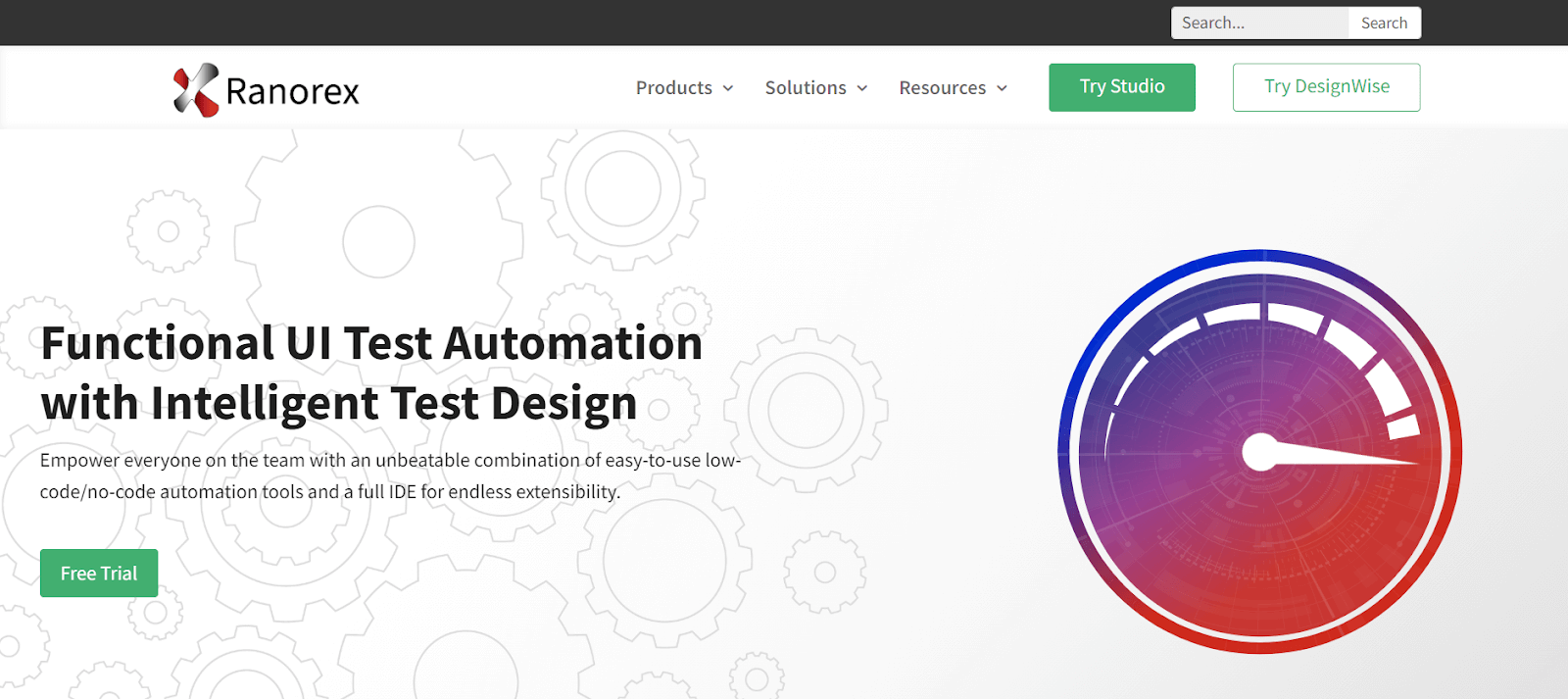
Key Features:
Simplifies the creation of automated UI tests through intuitive drag-and-drop actions, requiring no coding or scripting expertise.
Offers remote or local test automation capabilities on virtual or physical machines.
Supports parallel testing to execute test cases concurrently on multiple devices.
Comes with an object recognition by Ranorex Spy, enabling efficient inspection of UI components across desktop, web, and mobile applications.
Offers advanced debugging, refactoring, and code completion features to ensure efficient test creation and maintenance.
Integrates with DevOps tools to support automation testing.
15. SoapUI
It is an open-source QA testing tool for testing and debugging web services and APIs. It addresses the testing needs of web services and RESTful APIs operating within a client/server architecture. SoapUI offers a suite of automated tools for functional, regression, compliance, and load testing, thereby positioning itself as a versatile tool for API automation.
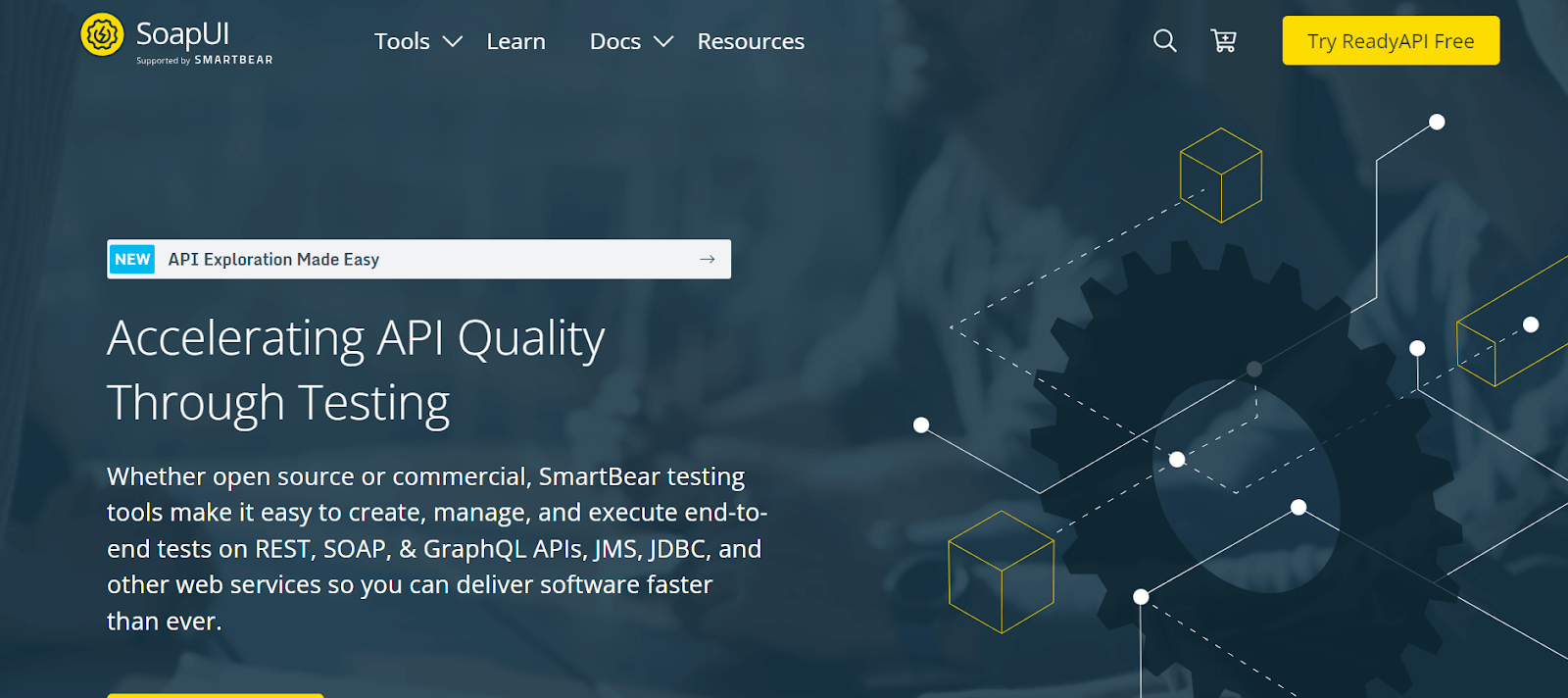
Key Features:
Offers a user-friendly interface suitable for both technical and non-technical folks.
Supports standard protocols and technologies, enabling testing of various APIs and web services.
Provides flexibility in developing custom plugins for different open-source environments.
Supports automating complex test cases, including asynchronous testing, to meet the demands of modern web services.
16. BugBug
BugBug is the low code QA testing tool to ensure the quality of the software applications. This tool helps in faster and cost-effective end-to-end testing through an intuitive recording interface. BugBug has a user-friendly interface that allows testers to create their initial automated tests in under 5 minutes, even without programming expertise.
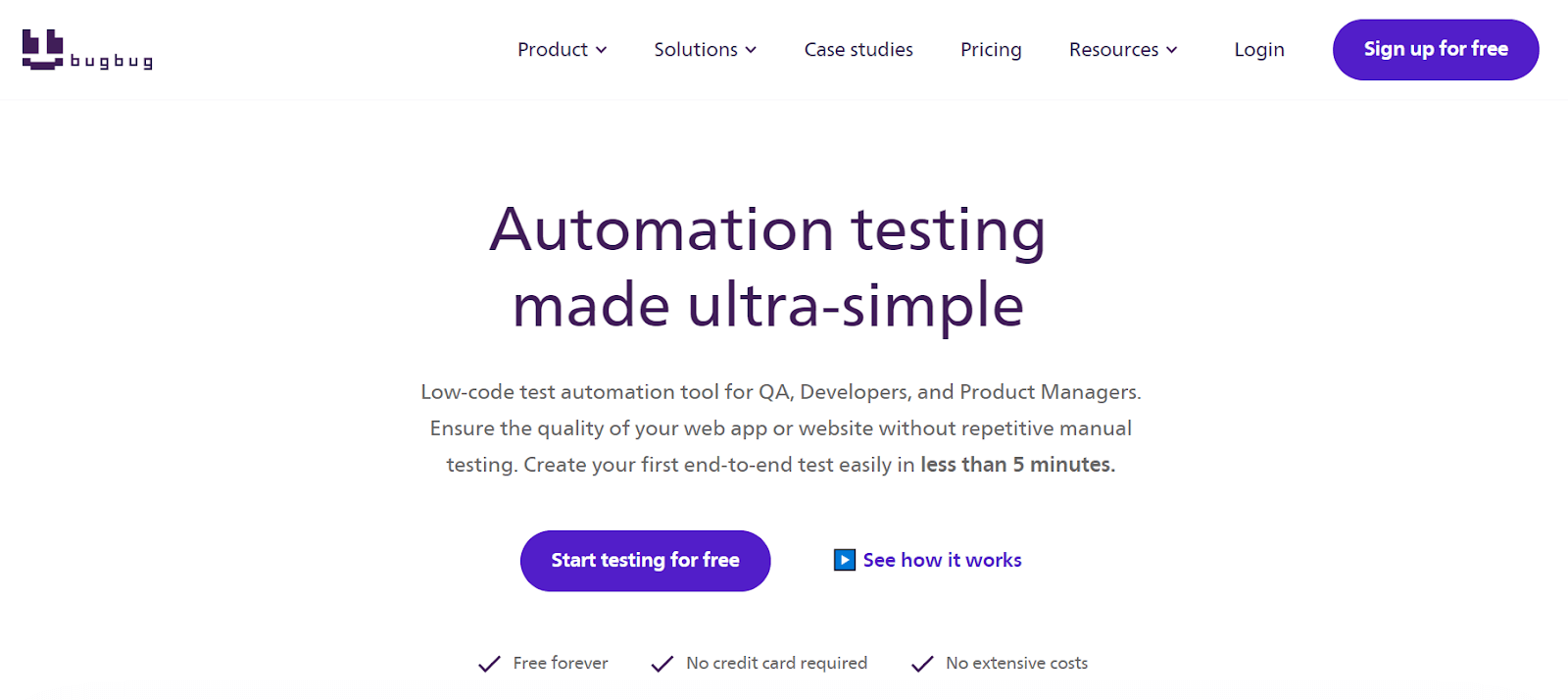
Key Features:
Records new tests by simply clicking in your browser, capturing every click or text input automatically.
Uses BugBug API and Command Line Interface to execute regression tests seamlessly within your CI/CD build pipelines, integrating with platforms like GitHub, GitLab, Travis CI, Jenkins, or Bitbucket.
Scrolls automatically to the appropriate position and execute clicks on elements like a real user.
Creates complex test scenarios spanning various domains or browser tabs effortlessly.
Runs multiple tests simultaneously in the cloud, reducing testing time by up to 16 times without requiring infrastructure modifications.
17. ACCELQ
ACCELQ works as a cloud-based continuous testing platform, offering API and web testing automation capabilities. It is for teams of varying sizes seeking to streamline their testing processes by automating various aspects of the testing process, such as test design, planning, test generation, and execution.

Key Features:
Allows users to effortlessly create and manage automated tests in the cloud without coding.
Facilitates team collaboration through in-sprint test automation, thereby breaking down invisible silos.
Comes with built-in test management capabilities that consolidate various types of software testing while seamlessly integrating with various tools.
Offers auto-healing automation to adapt to rapid-release changes, ensuring testing alignment with dynamic development environments.
Facilitates advanced traceability throughout every stage of the project life cycle, enabling smooth integration with CI/CD pipelines.
18. Katalon Studio
Katalon Studio is a no-cost QA testing tool that helps in automating websites, mobile applications, and web services. It facilitates test generation and execution management while developing team collaboration and feedback. Featuring record and playback and manual modes, it helps non-programmers in creating automation test cases effectively. For users with programming expertise, Katalon Studio offers a script mode that enables the writing of test scripts in Groovy.
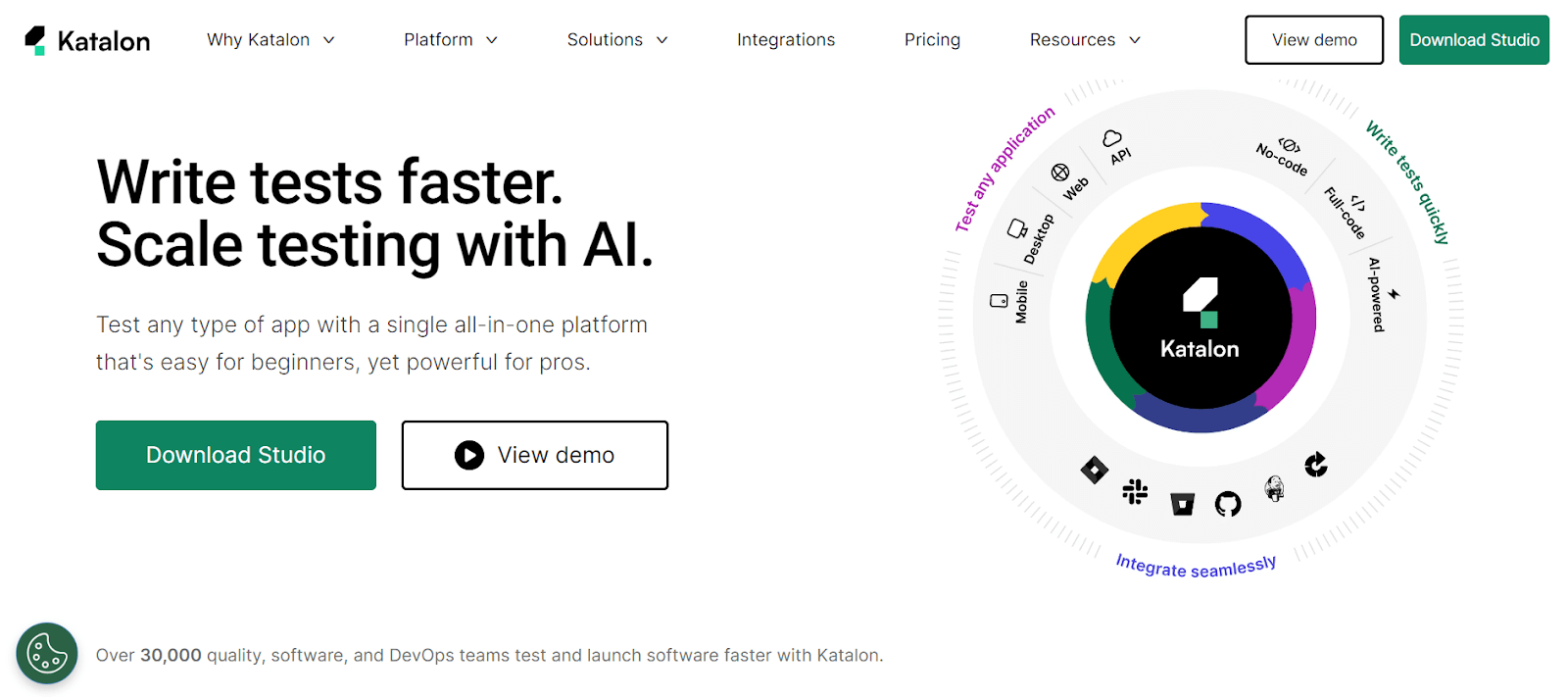
Key Features:
Offers scalable test automation that empowers project teams of all sizes worldwide.
Provides capabilities for performing cross-browser testing across macOS, Windows, and Linux for web automation and iOS and Android for mobile automation testing.
Facilitates codeless automation testing while validating web application UI elements.
Comes with built-in templates for managing the object repository, test cases, and custom keywords.
Provides seamless integration with Git, Jenkins, qTest, and Jira.
19. Tricentis Tosca
It is a continuous testing platform that automates end-to-end testing for software applications. It increases the speed and scalability of the testing process and aligns with the Agile and DevOps methodologies. Tricentis Tosca integrates various software testing components, enabling comprehensive testing of GUIs and APIs from a commercial standpoint, including test case creation, test automation, test data design and provisioning, and analytics.
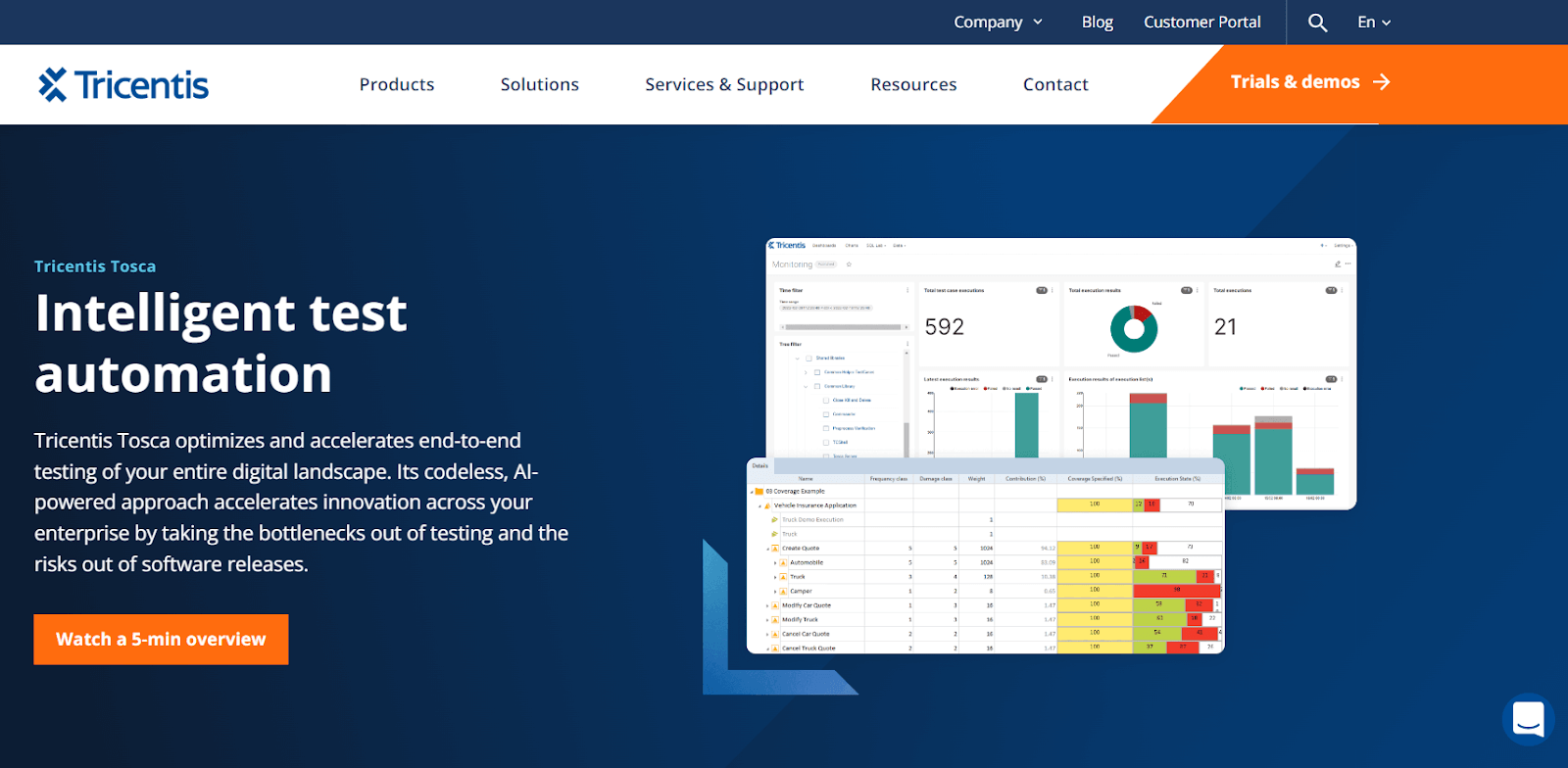
Top Features:
Provides service virtualization feature that resolves challenges encountered when testing responses from inaccessible systems.
Addresses testing from a risk-based perspective and enables the reduction of overall tests in your automation suite while mitigating risks in software releases.
Facilitates integration and automation across diverse DevOps toolchains.
Supports a wide array of testing scenarios, including cross-browser testing, mobile testing, SAP Fiori and SAP testing, Java testing, .NET testing, XML testing, JSON testing, REST testing, ServiceNow testing, and more.
20. Postman
It is a QA testing tool for API development. It includes a diverse suite of functionalities to improve different aspects of the API life cycle. It takes into account design and rigorous testing to thorough documentation and seamless collaboration and allows developers to expedite their API development process with accuracy.
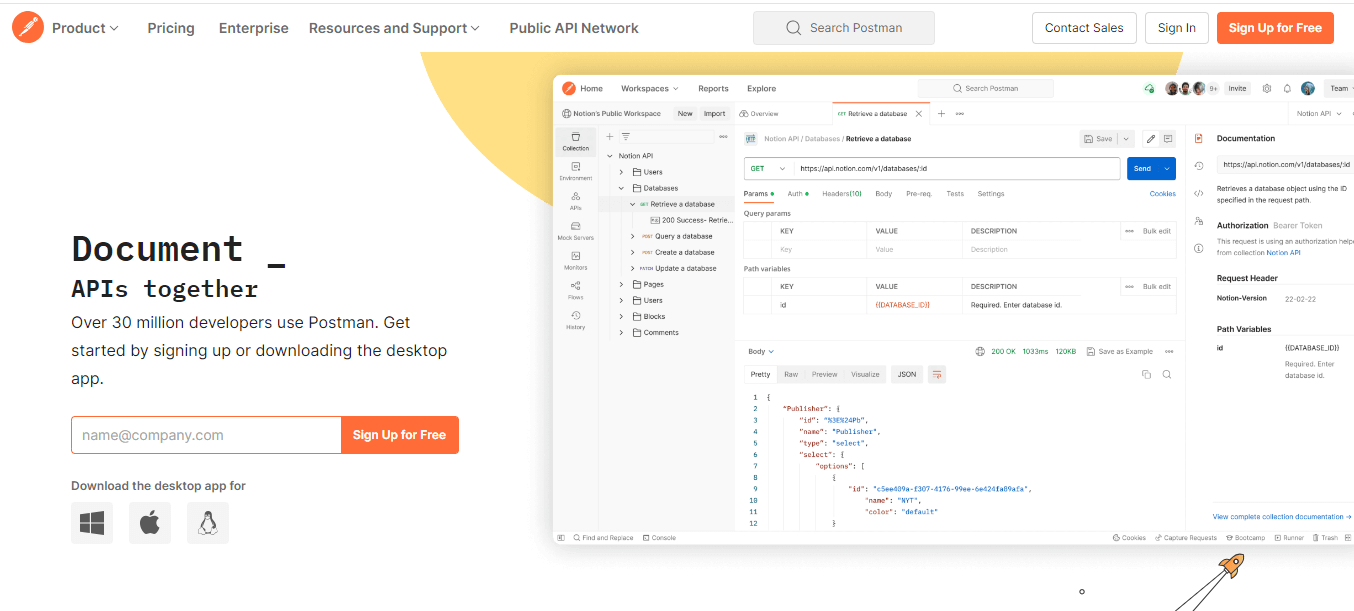
Key Features:
Enables programmatic access to data stored in your Postman account using Postman API.
Offers a programmable approach to visually represent request responses. Using HTML, CSS, and JavaScript, you can integrate visualization for the response body directly within Postman.
Simplifies adherence to the DRY (Don’t Repeat Yourself) software development principle by providing easy management of variables, scripts, and authentication credentials reused across multiple requests within a specific folder or collection.
21. Apache JMeter
Apache JMeter is an open-source tool for the performance, functional, and load testing of web applications. It facilitates load testing, evaluates functional behavior, and measures performance by simulating a heavy load with a vast number of concurrent users.
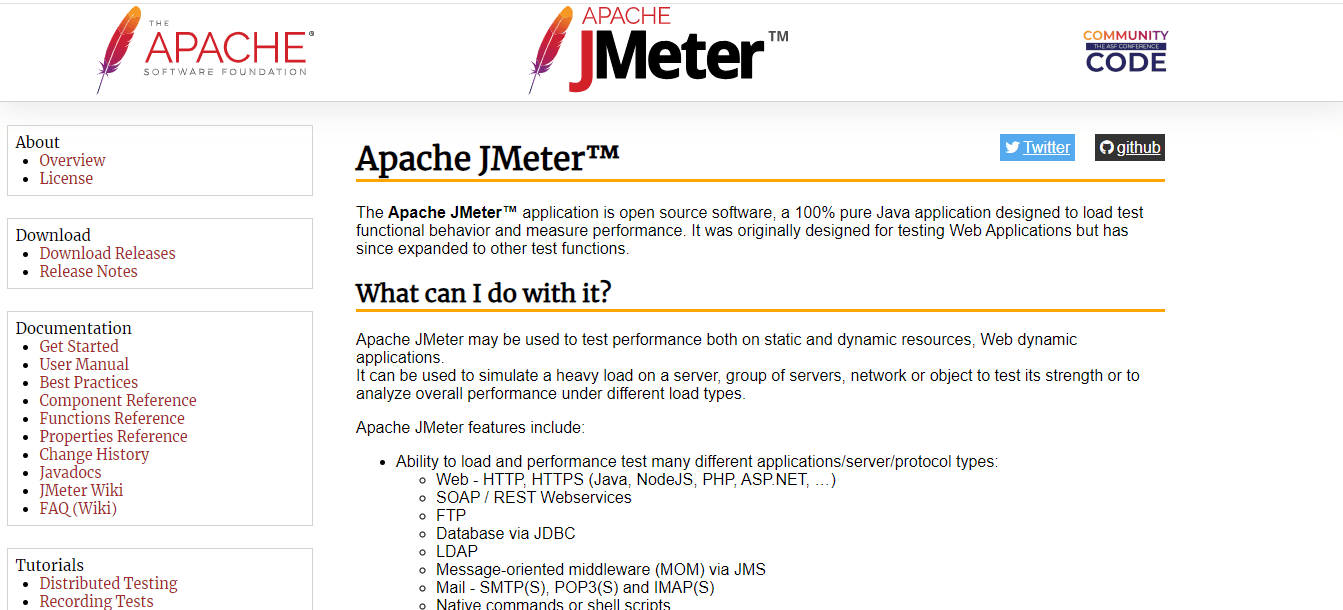
Key Features:
Performs load and performance tests for a wide range of server types, including web (HTTP, HTTPS), SOAP, database via JDBC, LDAP, JMS, and mail (POP3), among others.
Supports Swing and lightweight components.
Stores test plans in XML format, facilitating easy generation and customization using a text editor.
Enables concurrent sampling by multiple threads and simultaneous sampling of different functions by separate thread groups.
How to Select the Right QA Testing Tools?
As multiple QA testing tools are in the market, it is important to evaluate your software project requirements and team capabilities carefully. Afterward, you can select a QA testing tool that empowers your team to deliver high-quality software.
Following are the pointers that you need to consider when selecting QA testing tools:
Ensure your QA testing tool addresses the needs of developers and automation experts.
Look for QA testing tools suitable for business analysts, subject matter experts, and others without programming backgrounds.
Opt for QA testing tools that support testing across various operating systems, browsers, and mobile devices.
Figure out tools with pre-built templates and wizards to simplify testing for specific applications like ServiceNow, Salesforce, or SAP.
Consider QA testing tools that cover UI and API formats across desktop, web, mobile, AR/VR, IoT, and cloud applications.
Choose QA testing tools incorporating AI, machine learning, self-healing capabilities, bots, and automated test generation.
Consider tools that support and extend open-source testing frameworks.
Look for tools that integrate seamlessly with DevOps, Agile planning, and Application Lifecycle Management (ALM) solutions.
Prioritize QA testing tools offering comprehensive dashboards and analytics to monitor overall test progress, sprint activities, and individual tests.
Choose QA testing tools that are user-friendly and seamlessly integrated with existing tools.
Select tools that can handle the test suite as the application scales, enabling QA teams and processes to keep up with the pace and complexity of development.
Conclusion
QA automation is the most crucial part of the software development process as it ensures the accurate functioning and performance of the software applications. The QA process requires the choice of the right QA testing tools so that developers and testers can detect bugs in the early stage and expedite the release of the software application. This blog covers the 21 best QA testing tools you can choose based on your needs.
Explore them individually and consider the factors we have discussed in this blog to make a decision.